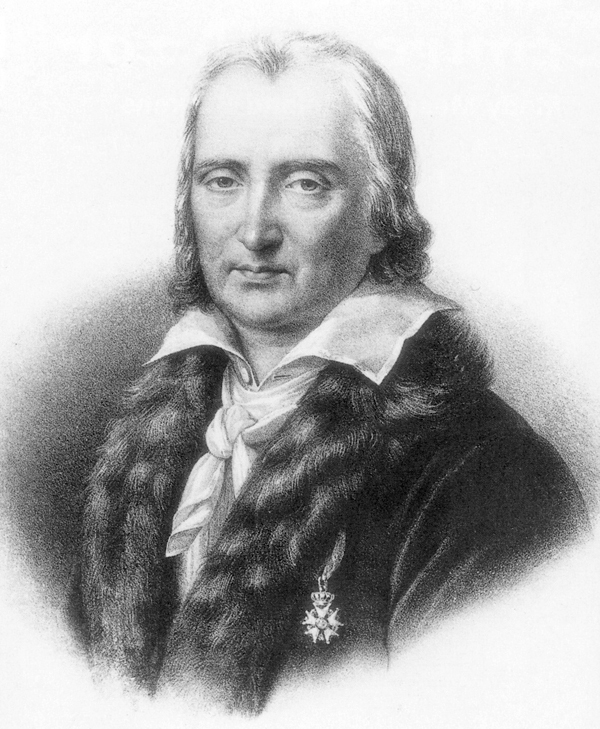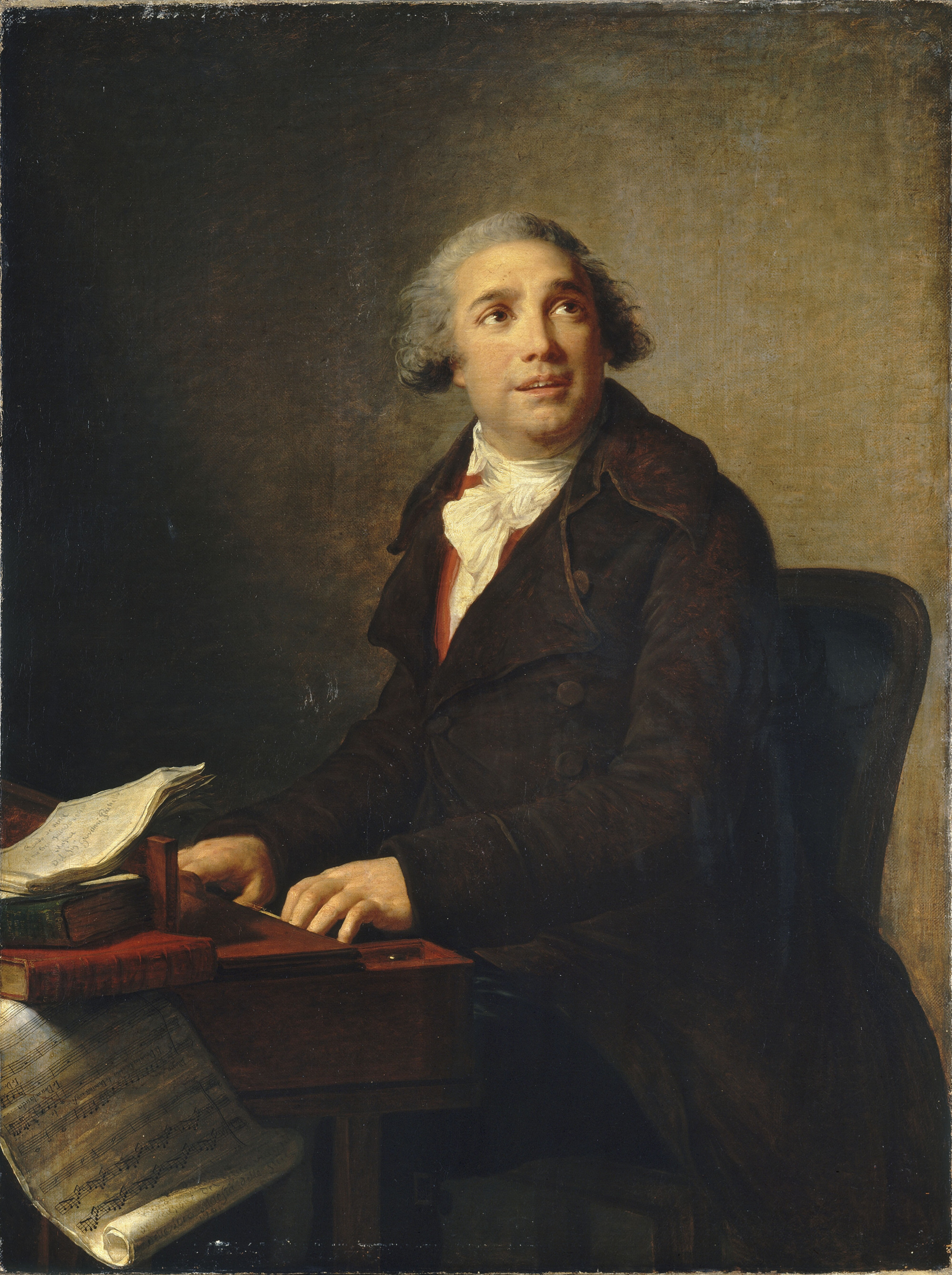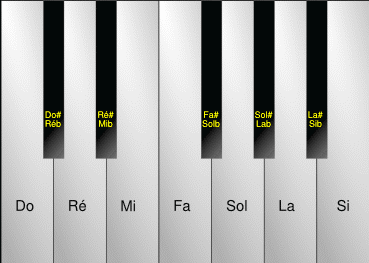|
Jean-François Le Sueur
Jean-François Le Sueur (more commonly Lesueur; ; 15 February 17606 October 1837) was a French composer, best known for his oratorios and operas. Life He was born at Plessiel, a hamlet of Drucat near Abbeville, to a long-established family of Picardy, the great-nephew of the painter Eustache Le Sueur. Beginning as a chorister at the collegial church of Abbeville, then at the Amiens Cathedral, cathedral of Amiens, where he pursued his music studies, Le Sueur was named chorus master at the cathedral of Sées. He went to Paris to study harmony with the Abbé Nicolas Roze, chorus master at the Saints-Innocents. Le Sueur was named to positions at Dijon (1779), Le Mans (1782), then at Tours (1783) before he succeeded Roze at the Saints-Innocents at Paris. Finally, in 1786, after a competition, he was made music director at Notre-Dame de Paris. For the Feast of the Assumption, he innovated by introducing an orchestra, with great success, and his sacred concerts at the main feasts of th ... [...More Info...] [...Related Items...] OR: [Wikipedia] [Google] [Baidu] |
Drucat
Drucat (; Picard language, Picard: ''Drucot'' ) is a Communes of France, commune in the Somme (department), Somme Departments of France, department in Hauts-de-France in northern France. Geography Drucat is situated on the D82e road, some northeast of Abbeville. Population History There was a station on the Réseau des Bains de Mer, called ''Plessiel-Drucat'', which opened on 19 June 1892 and closed on 10 March 1947. Places of interest *Saint Martin's church. *The recently restored chapel. *Plessiel water-tower Personalities *The composer Jean-François Lesueur (1760–1837) was born at Plessiel, a hamlet within the commune of Drucat. The village hall is named in his honour. See also *Communes of the Somme department *Réseau des Bains de Mer References Communes of Somme (department) {{Abbeville-geo-stub ... [...More Info...] [...Related Items...] OR: [Wikipedia] [Google] [Baidu] |
Paris Conservatoire
The Conservatoire de Paris (), or the Paris Conservatory, is a college of music and dance founded in 1795. Officially known as the Conservatoire National Supérieur de Musique et de Danse de Paris (; CNSMDP), it is situated in the avenue Jean Jaurès in the 19th arrondissement of Paris, France. The Conservatoire offers instruction in music and dance, drawing on the traditions of the 'French School'. Formerly the conservatory also included drama, but in 1946 that division was moved into a separate school, the Conservatoire National Supérieur d'Art Dramatique (CNSAD), for acting, theatre and drama. Today the conservatories operate under the auspices of the Ministry of Culture and Communication and are associate members of PSL University. The CNSMDP is also associated with the Conservatoire National Supérieur de Musique et de Danse de Lyon (CNSMDL). History École Royale de Chant On 3 December 1783 Papillon de la Ferté, ''intendant'' of the Menus-Plaisirs du Roi, pr ... [...More Info...] [...Related Items...] OR: [Wikipedia] [Google] [Baidu] |
André Grétry
André Ernest Modeste Grétry (; baptised 11 February 1741; died 24 September 1813) was a composer from the Prince-Bishopric of Liège (present-day Belgium), who worked from 1767 onwards in France and took French nationality. He is most famous for his '' opéras comiques''. His music influenced Mozart and Beethoven both of whom wrote variations on his works. Biography He was born at Liège, his father being a poor musician. He was a choirboy at the church of St. Denis (Liège). In 1753 he became a pupil of Jean-Pantaléon Leclerc and later of the organist at St-Pierre de Liège, Nicolas Rennekin, for keyboard and composition and of Henri Moreau, music master at the collegiate church of St. Paul. But of greater importance was the practical tuition he received by attending the performance of an Italian opera company. Here he heard the operas of Baldassarre Galuppi, Giovanni Battista Pergolesi, and other masters; and the desire of completing his own studies in Italy was the ... [...More Info...] [...Related Items...] OR: [Wikipedia] [Google] [Baidu] |
Académie Des Beaux-Arts
The (; ) is a French learned society based in Paris. It is one of the five academies of the . The current president of the academy (2021) is Alain-Charles Perrot, a French architect. Background The academy was created in 1816 in Paris as a merger of the Académie de peinture et de sculpture (Academy of Painting and Sculpture, founded 1648), the Académie de musique (Academy of Music, founded in 1669) and the Académie d'architecture (Academy of Architecture, founded in 1671). Awards Currently, the provides several awards including five dedicated prizes: . Prix et Concours. * Liliane Bettencourt Prize for Choral Singing * [...More Info...] [...Related Items...] OR: [Wikipedia] [Google] [Baidu] |
Giovanni Paisiello
Giovanni Paisiello (or Paesiello; 9 May 1740 – 5 June 1816) was an Italian composer of the Classical era, and was the most popular opera composer of the late 1700s. His operatic style influenced Mozart and Rossini. Life Paisiello was born in Taranto in the Apulia region and educated by the Jesuits there. He became known for his beautiful singing voice and in 1754 was sent to the Conservatorio di S. Onofrio at Naples, where he studied under Francesco Durante, and eventually became assistant master. For the theatre of the Conservatorio, which he left in 1763, he wrote some intermezzi, one of which attracted so much notice that he was invited to write two operas, ''La Pupilla'' and ''Il Mondo al Rovescio'', for Bologna, and a third, ''Il Marchese di Tidipano'', for Rome. His reputation now firmly established, he settled for some years at Naples, where, despite the popularity of Niccolò Piccinni, Domenico Cimarosa and Pietro Guglielmi, of whose triumphs he was bitterly je ... [...More Info...] [...Related Items...] OR: [Wikipedia] [Google] [Baidu] |
Tuileries
The Tuileries Palace (, ) was a palace in Paris which stood on the right bank of the Seine, directly in the west-front of the Louvre Palace. It was the Parisian residence of most French monarchs, from Henri IV to Napoleon III, until it was burned by the Paris Commune in 1871 and demolished in 1883. Construction began in 1564, originally to serve as a home for Queen Catherine de' Medici, and was gradually extended until it closed off the western end of the courtyard and displayed an immense façade of 266 metres. Since the destruction of the Tuileries, the courtyard has remained open to the west, and the site now overlooks the eastern end of the Tuileries Garden, forming an elevated terrace between the Place du Carrousel and the gardens proper. History Plan of Catherine de' Medici (16th century) The site of the Tuileries Palace was originally just outside the walls of the city, in an area frequently flooded by the Seine as far as the present Rue Saint-Honoré. The land wa ... [...More Info...] [...Related Items...] OR: [Wikipedia] [Google] [Baidu] |
Napoleon
Napoleon Bonaparte (born Napoleone di Buonaparte; 15 August 1769 – 5 May 1821), later known by his regnal name Napoleon I, was a French general and statesman who rose to prominence during the French Revolution and led Military career of Napoleon, a series of military campaigns across Europe during the French Revolutionary and Napoleonic Wars from 1796 to 1815. He led the French First Republic, French Republic as French Consulate, First Consul from 1799 to 1804, then ruled the First French Empire, French Empire as Emperor of the French from 1804 to 1814, and briefly again in 1815. He was King of Italy, King of Kingdom of Italy (Napoleonic), Italy from 1805 to 1814 and Protector of the Confederation of the Rhine, Protector of the Confederation of the Rhine from 1806 to 1813. Born on the island of Corsica to a family of Italian origin, Napoleon moved to mainland France in 1779 and was commissioned as an officer in the French Royal Army in 1785. He supported the French Rev ... [...More Info...] [...Related Items...] OR: [Wikipedia] [Google] [Baidu] |
Académie Royale De Musique
The Paris Opera ( ) is the primary opera and ballet company of France. It was founded in 1669 by Louis XIV as the , and shortly thereafter was placed under the leadership of Jean-Baptiste Lully and officially renamed the , but continued to be known more simply as the . Classical ballet as it is known today arose within the Paris Opera as the Paris Opera Ballet and has remained an integral and important part of the company. Currently called the , it mainly produces operas at its modern 2,723-seat theatre Opéra Bastille which opened in 1989, and ballets and some classical operas at the older 1,979-seat Palais Garnier which opened in 1875. Small scale and contemporary works are also staged in the 500-seat Amphitheatre under the Opéra Bastille. The company's annual budget is in the order of 200 million euros, of which €100M come from the French state and €70M from box office receipts. With this money, the company runs the two houses and supports a large permanent staff, w ... [...More Info...] [...Related Items...] OR: [Wikipedia] [Google] [Baidu] |
La Mort D'Adam
''La mort d'Adam'' (, ) is a tragédie lyrique on a biblical theme in 3 acts by Jean-François Le Sueur with a French libretto by Nicolas-François Guillard after Klopstock, first performed in 1809, though written a few years earlier. Musicologist Winton Dean described the work as "the most comprehensive and spectacular opera ever conceived", noting that it "combines a Klopstock play with substantial portions of the Book of Genesis and ''Paradise Lost''" and a cast which extends from "the entire human race... the total population of heaven and hell", and with a " Leitmotiv system" of twelve themes, some recalled in combination. Composition and performance history Le Sueur wrote the opera while working as an instructor at the Conservatoire de Musique in Paris. The opera was initially scheduled to be performed at the Conservatoire but was dropped in favor of Charles-Simon Catel's '' Sémiramis''. Upset over this decision, Le Sueur published anonymously a pamphlet entitled , in wh ... [...More Info...] [...Related Items...] OR: [Wikipedia] [Google] [Baidu] |
Ossian, Ou Les Bardes
''Ossian, ou Les bardes'' (English: ''Ossian, or The Bards'') is an opera in five acts by the French composer Jean-François Le Sueur. The libretto, by Alphonse François "Paul" Palat-Dercy and Jacques-Marie Deschamps, is based on the Ossian poems of James Macpherson (specifically the poem "Calthon and Colmal"), which had been translated into French by . Performance history Le Sueur probably began work on the opera as early as 1795. It was first performed at the Paris Opera on 10 July 1804. The premiere was a huge success, especially with Emperor Napoleon, who was a great admirer of the Ossian poems. Napoleon was so enthusiastic, he invited the composer to join him in the imperial box at the third act and the next day he sent Le Sueur a gold casket engraved "The Emperor Napoleon to the author of ''Les bardes''", containing the cross of the Légion d'honneur. The opera received almost 70 performances over the next 12 years. Roles Synopsis The opera is set in an imaginary Scotlan ... [...More Info...] [...Related Items...] OR: [Wikipedia] [Google] [Baidu] |
Solfège
In music, solfège (British English or American English , ) or solfeggio (; ), also called sol-fa, solfa, solfeo, among many names, is a mnemonic used in teaching aural skills, Pitch (music), pitch and sight-reading of Western classical music, Western music. Solfège is a form of solmization, though the two terms are sometimes used interchangeably. Syllables are assigned to the notes of the Scale (music), scale and assist the musician in Gordon music learning theory#Audiation, audiating, or mentally hearing, the pitches of a piece of music, often for the purpose of singing them aloud. Through the Renaissance music, Renaissance (and much later in some shapenote publications) various interlocking four-, five- and six-note systems were employed to cover the octave. The tonic sol-fa method popularized the seven syllables commonly used in English-speaking countries: ''do'' (spelled ''doh'' in tonic sol-fa),''Oxford English Dictionary'' 2nd Ed. (1998) ''re'', ''mi'', ''fa'', ''so(l)'' ... [...More Info...] [...Related Items...] OR: [Wikipedia] [Google] [Baidu] |
Charles Simon Catel
Charles-Simon Catel (; 10 June 1773 – 29 November 1830) was a French composer and educator born at L'Aigle, Orne. Biography Catel studied at the Royal School of Singing in Paris. He studied composition with François-Joseph Gossec and by the age of 16 became his chief assistant at the orchestra of the National Guard in 1790. A member of the Institute, he jointly composed pieces of military music for official state ceremonies, including ''L'Hymne à la Victoire'' (Victory Hymn), with words by Ponce-Denis Écouchard-Lebrun. He was appointed inaugural professor of harmony at the Conservatoire de Paris, but was relieved of his duties in 1814. Amongst his students were the Prix de Rome winning composers Joseph Daussoigne-Méhul and Victor Dourlen, the Belgian composer Martin-Joseph Mengal, and the famous, if eccentric, harpist Nicolas-Charles Bochsa. Catel died in Paris. His works include a ''Treatise on Harmony'' (1802), which was used by the young Berlioz, several concert ... [...More Info...] [...Related Items...] OR: [Wikipedia] [Google] [Baidu] |






